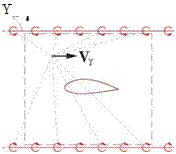Modeling Non-uniqueness
In any given practical application, the flow-field representation via sources or vortices is non-unique, in that different source, vortex, and freestream combinations can give the same velocity field. For example, the source sheet superposition (2.64) and the vortex sheet superposition (2.67) can both represent exactly the same (non-lifting) flow-field about the body. There will be a different velocity within the body, but that is physically irrelevant.
The non-uniqueness extends even to the freestream component of the flow-field. For example, in the general velocity superposition (2.3) the freestream can be represented either as a specified constant, or via infinite source sheets or vortex sheets, as sketched in Figure 2.13. Using a constant added Vb to represent a uniform flow is of course the simplest and the preferred approach in applications.
This representation non-uniqueness gives rise to many different possible types of panel methods, based either on source sheets, or vortex/doublet sheets, or both. Katz and Plotkin [4] give an overview of many such alternative formulations.
 |
 |
 |
Figure 2.13: Three methods for imposing a uniform velocity (e. g. to represent a freestream V) on the region of interest inside the dashed box: via the uniform added velocity Vb, via two infinite source sheets, and via two infinite vortex sheets. All are valid, but using V is simplest. The three representations also have different velocities outside the dashed box.













